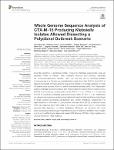Whole Genome Sequence Analysis of CTX-M-15 Producing Klebsiella Isolates Allowed Dissecting a Polyclonal Outbreak Scenario
Becker, Laura
Fuchs, Stephan
Pfeifer, Yvonne
Semmler, Torsten
Eckmanns, Tim
Korr, Gerit
Sissolak, Dagmar
Friedrichs, Michael
Zill, Edith
Tung, Mei-Lin
Dohle, Christian
Kaase, Martin
Gatermann, Sören
Rüssmann, Holger
Steglich, Matthias
Haller, Sebastian
Werner, Guido
Extended-spectrum β-lactamase (ESBL) producing Klebsiella pneumoniae pose an important threat of infection with increased morbidity and mortality, especially for immunocompromised patients. Here, we use the rise of multidrug-resistant K. pneumoniae in a German neurorehabilitation center from April 2015 to April 2016 to dissect the benefit of whole genome sequencing (WGS) for outbreak analyses. In total, 53 isolates were obtained from 52 patients and examined using WGS. Two independent analysis strategies (reference-based and -free) revealed the same distinct clusters of two CTX-M-15 producing K. pneumoniae clones (ST15, n = 31; ST405, n = 7) and one CTX-M-15 producing Klebsiella quasipneumoniae strain (ST414, n = 8). Additionally, we determined sequence variations associated with antimicrobial resistance phenotypes in single isolates expressing carbapenem and colistin resistance, respectively. For rapid detection of the major K. pneumoniae outbreak clone (ST15), a selective triplex PCR was deduced from WGS data of the major outbreak strain and K. pneumoniae genome data deposited in central databases. Moreover, we introduce two novel open-source applications supporting reference genome selection (refRank; https://gitlab.com/s.fuchs/refRank) and alignment-based SNP-filtering (SNPfilter; https://gitlab.com/s.fuchs/snpfilter) in NGS analyses.
Dateien zu dieser Publikation
Keine Lizenzangabe

